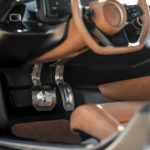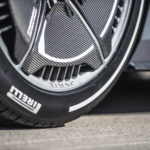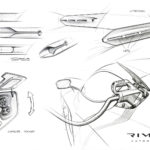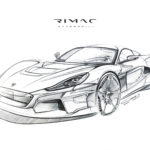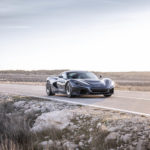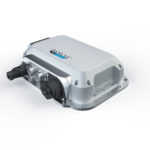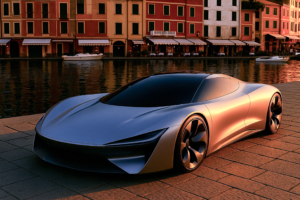Rimac C_TWO unveiled in Geneva (with sketches)


The Rimac C_Two is a pure electric GT hypercar as capable on track as it is crossing continents. A car as bespoke as it is user-friendly. Configurable, personal and extremely powerful, representing what is possible when true innovation and passion is allowed free rein. Building on the knowledge gleaned from the brilliantly powerful Rimac Concept_One, the all-new C_Two combines the very best materials and bespoke technology to produce something both revolutionary and eminently useable, with performance and character that elevates the genre. There is – quite literally – no other car like it.
- Top Speed: 412 km/h / 258 mph
- Acceleration 0-60 mph: 1.85* seconds
- Power: 1,914hp / 1,408 kW
- Motor Torque: 2,300 Nm
- Range: 650 km (NEDC)
- Units: 150
Astounding performance, unprecedented functionality
- 1,914 hp creating incredible acceleration of 0-60 mph in 1,85* sec and 0-300 km/h in 11,8* sec
- An innovative battery pack in technology and layout delivers 120 kWh energy and 1.4MW of power with exceptional thermal management allowing for two full laps of the infamous Nürburgring at full power – with a negligible drop in performance.
- As a true Grand Tourer the C_Two provides a generous 650 km (NEDC) range, a spacious cockpit with the highest quality materials, and even a configurable and genuinely practical trunk – enough to make long-distance electric touring comfortable.
- Next-generation R-AWTV (Rimac All-Wheel Torque Vectoring) controls four electric motors, one per each wheel and enables both the safety features such as advanced ABS and ESP as well as a uniquely adaptable all-wheel drive – everything from ultimate grip to rear-wheel drive dynamism, depending on the driver’s preference
- Design and technology perfectly blended
- Recognisable Rimac design DNA integrating a variety of aerodynamic features
- On-board AI – one of the smartest and most connected cars in the world
- Eight on-board cameras, a lidar sensor, six radar emitters and twelve ultrasonic sensors
- Level 4 autonomous ready hardware is not about replacing the driver but enhancing his experience
- ‘Driving Coach’ overlays selected racetracks provide real-time information on racing lines and braking points
- Facial recognition in lieu of a traditional key
- Performance ADAS (Advanced Driver Assistance Systems) and response-monitoring software that changes the car’s character depending on the driver’s mood or the prevailing weather conditions
*one foot roll-out
Designed by Rimac’s in-house team and made entirely from scratch with all-new, groundbreaking technologies – the C_Two features a full carbonfibre monocoque with bonded carbon roof, integrated battery pack and merged rear carbon subframe. Crash structures are formed from aluminium, and the body itself is pure carbonfibre, with the result that it is both relatively light and exceptionally strong. Double wishbone suspension with electronically-controlled dampers and active height adjustment provide a smooth and comfortable ride, with four electric motors powering each individual wheel giving both four-wheel drive and unprecedented levels of dynamic control. And while a pair of independent single-speed gearboxes apply drive to the front wheels, a pair of independent two-speed, gearboxes – one for each rear wheel – allow the C_Two to make use of its prodigious torque to produce both mind-blowing acceleration and true hypercar top speed.
Carefully integrated into the graceful, agile form are a variety of active elements, from flaps in the hood that alter the C_Two’s aerodynamic profile, to a rear wing that adopts different positions according to dynamic loads and operates as a full air-brake to stabilise the car under heavy braking.
A flat floor and active rear venturi also ensure that the C_Two is both aerodynamically efficient and stable at speed – again necessary with a car capable of such outrageous numbers. Even the lightweight forged wheels have an aerodynamic function, ensuring that the braking system is fed with cooling air while allowing smooth airflow down the flanks of the car at speed. Various cooling channels are also animate, to ensure the best possible efficiency and performance at all times.
Rimac’s own suite of electronic control systems means that full torque-vectoring is available (and necessary!) to harness 1,914 hp (1,408 kW) of power and 2,300 Nm of torque – two and a half times the torque output of a contemporary hypercar. R-AWTV (Rimac All-Wheel Torque Vectoring) replaces traditional Electronic Stability Program and Traction Control systems and enables infinitely variable dynamic responses, from full grip to extended drifting capability, to satisfy even the most demanding of drivers. With such power comes responsibility: The C_Two is equipped with the latest braking technology. In addition to a maximum regenerative braking of 150 kW, huge 390mm Brembo CCMR carbon ceramic brake discs and six-piston calipers feature on both the front and rear axles, allowing for fade-free, powerful deceleration.
With a top speed of 258 mph (412 km/h), a zero to 60mph time of 1.85* seconds and a zero to 100 mph (161 km/h) time of 4.3*, the C_Two makes devastating use of the instant-torque available to an electric vehicle and the traction made possible by the unique drivetrain and bespoke Pirelli tyres. More than that, the C_Two maintains its eye-widening acceleration throughout a full-throttle cycle, achieving 186 mph (300 km/h) from rest in just 11.8* seconds. Such shattering ability equates to a quarter-mile time of just 9.1* seconds – a figure usually only associated with specialist racing machinery.
Yet the C_Two is a comfortable, bespoke GT car that has a 650 km range (NEDC), can be charged to 80-percent capacity in less than 30 minutes, and has been designed to be used hard, repeatedly and reliably. This is no fragile thoroughbred; new and innovative, liquid-cooled thermal management systems mean that this is a car capable of two full laps of the infamous Nürburgring at full power – with a negligible drop in performance.
*one foot roll-out
It remains a vital aspect of a true hypercar that, no matter how extreme the performance, it must always engage and excite the driver. The C_Two features a triplet of high-definition TFT screens (cluster, central screen and co-driver’s display), which present as much, or as little, information as required.
Gorgeously tactile billet aluminium rotary controls and switches – including three displays with rotating control – provide a resolutely analogue feel tailored to make use of cutting-edge digital technology. From the cockpit, the driver can monitor every aspect of the car’s performance with real-time telemetry – downloadable to a laptop or smartphone for later review.
As part of the suite of electronics that comes with advanced autonomous capability, the Driving Coach configuration in the C_Two is capable of overlaying selected race tracks in real-time, offering clear and precise audio, visual and direct guidance on racing lines, braking/acceleration points and steering inputs. A near-gaming experience, with real-world excitement.
The same artificial intelligence will provide intervention and active safety as ‘ADAS’ (advanced driver-assistance system) while on the road: collision risk prediction combined with automatic emergency braking and evasive control, to blind-spot monitoring, lane-keep assist and fully adaptive cruise control including traffic pilot functionality. AI capabilities are enabled by the state-of-art NVIDIA hardware.
However, the C_Two is, at its heart, always a driver’s car, capable of engaging and exciting anyone, from novice to experienced racer. It is amazingly user-friendly, incredibly effective and filled with unique character. Even the ownership experience is unlike any other, since the ownership of a C_Two is more than just the buying of an object. It is the start of an intimate relationship with a brand. Once a customer has purchased a Rimac, they are invited into the family. A set of customization options is available, designed and developed in-house to make any C_Two as completely individual as the owner, and with the production process on-site at Rimac’s facility, anything is possible.
Rimac Automobili is a specialist technology company: a designer, developer and manufacturer of ultimate and bespoke performance electric vehicles. Based in a modern facility just outside of Zagreb, Croatia, it is the brainchild of Mate Rimac, a visionary pioneer of electric vehicle technologies. Now employing well over 350 people, the company specialises in the very forefront of electric powertrains and integrated systems. Rimac is a trusted supplier to global OEMs, from Aston Martin to Renault, Jaguar Land Rover, Koenigsegg, Siemens and many more.
Indeed, Rimac is responsible for the hybrid systems in the forthcoming super-high-performance Aston Martin Valkyrie project, and has supplied both expertise and hardware to many current and future OEM projects, including Nobuhiro ‘Monster’ Tajima’s famous EV 2015/2016 Pike’s Peak EV hillclimb car. It also specialises in bespoke EV engineering solutions – from full powertrain to batteries and infotainment systems.
As a manufacturer, it is an agile, reliable operation, capable of producing many key technologies on-site: from battery packs to motors and gearboxes, infotainment systems and electronics to bespoke control systems for various applications. Rimac’s fully vertically-integrated teams can design and
GENEVA INTERNATIONAL MOTOR SHOW: RIMAC UNVEILS C_TWO | 06.03.2018.
engineer everything from billet switches to full vehicle, from titanium fixings to sophisticated simulation and prediction software. Literally everything, from bolts to bytes.
Founder, innovator and inveterate inventor Mate Rimac started out in 2007 in a borrowed garage, tinkering, dreaming and already thinking several years ahead of the traditional car industry. He fitted an experimental EV drivetrain to his 1984 BMW E30 and his conversion was so successful, the humble, garage-built BMW gained several FIA approved and Guinness World Records for electric vehicles, including ‘fastest accelerating EV’ over 1/8th and 1/4 miles, ½ km, 1 km and 1 mile.
This was the catalyst Mate needed to aim higher and seek out investors willing to fund his desire to build a bespoke, ground-breaking car from scratch. In 2009 Rimac Automobili was born. But making a real production car isn’t easy – many said that a supercar EV was impossible and even undesirable.
Mate didn’t listen. He brought together a lean team of similar-minded experts and in 2011 the Rimac Concept_One became the world’s first true electric supercar. With 1224 hp, the fiendishly clever all-wheel drive and torque-vectoring system saw it produce performance figures that outperformed even the most expensive contemporary hypercars.
With the 2018 launch of the C_Two from a dedicated, skilled and passionate team in Croatia, Mate looks set to join the pantheon of entrepreneurial businessmen that make their dreams reality and prove that limits are reserved for others.
The Rimac C_Two: the evolution of the hypercar
Performance
Acceleration: 0-60 mph 1.85 seconds*
Acceleration: 0-100 km/h (0-62 mph) 1.97 seconds*
Acceleration: 0-300 km/h 11.8 seconds*
Acceleration: 1/4 mile 9.1 seconds*
Top speed: 412 km/h / 258 mph
Power output: 1,914 hp / 1,408 kW
Motor torque: 2,300 Nm (0 – 6.600 RPM )
Wheel torque 1st gear: 17,047 Nm
Range: 650 km* (NEDC)
22kw 3-phase on-board charging
250kw fast charging (<30 mins 0-80% soc)
Power-to-weight ratio: 0.9 hp/kg
Weight distribution: 48% front 52% rear
Battery pack
Chemistry: Lithium manganese nickel
Number of cells: 6,960
Cell format: Cylindrical 21700 form-factor
Maximum voltage: 720V
Cooling: liquid
Capacity 120 kWh
Power: 1.4 MW
7 cooling systems and radiators
48V pumps and fans
Dimensions
Length 4750 mm
Width 1986 mm
Height 1208 mm
Wheelbase 2745 mm
Weight 1950 kg
Chassis and structure
Carbon fibre monocoque with integrated structural battery pack and bonded carbon fibre roof
Carbon fibre rear subframe merged with the tub
Carbon fibre and aluminium crash structures
Suspension: Double- A-arm wishbone suspension with electronically adjustable dampers and active ride-height.
Safety systems
Airbags:
– Driver airbag (steering wheel)
Passenger airbag
Side airbag (lamella bag installed in the door at belt line)
Seatbelt (complete system)
Airbag control unit (ECU) and crash sensors
– Active safety: collision risk prediction and automatic emergency braking with evasive control (steering and motion planning) for collision avoidance
– Dynamic safety: Torque Vectoring with stability function, traction control and ABS
– Structural: pre-preg monocoque passenger cell with aluminum and carbon-fibre crash structures and deformation zones.
Aerodynamics
Active elements: front diffusors, rear diffusor, rear wing, bonnet turning vane, underbody inlets and outlets
Cd in low-drag mode: 0.28
Control: central control system coordinating torque vectoring, active aerodynamics and suspension
ADAS
8 cameras (including front stereo vision)
1 Lidar
6 Radars
12 Ultrasonic sensors












